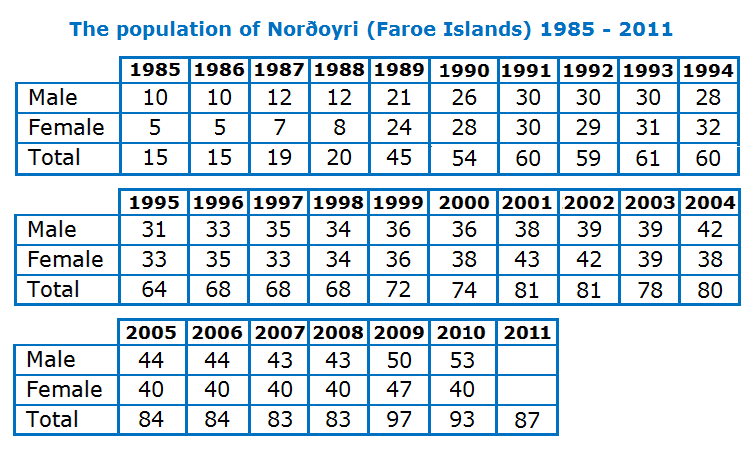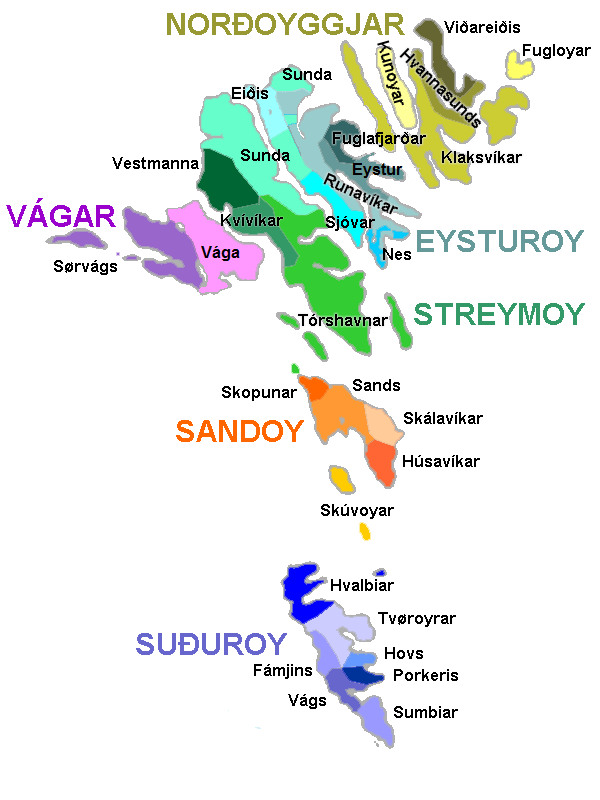|
Norðoyri
Norðoyri ( da, Nordøre) is a village in the Faroe Islands on the northern island of Borðoy. It belongs to the municipality of Klaksvík. Geography Norðoyri has an elongated settlement character and is sited along the eastern shore of the fjord Borðoyarvík that opens up in a SE direction. The lengthy 'infield' lines the shore. The 'outfield' covers the SE half of the peninsula between Borðoyarvík and Árnafjørður. It descends rather steeply from the central mountain-ridge, 400 to 563 m high, and specially in the SE part there are steep slopes and this outfield is generally regarded as difficult to tend and dangerous, as many sheep are lost there in severe winters. History Norðoyri is first mentioned in writing in 1584, but excavations at Islendingatoftir, a few miles south of Norðoyri have demonstrated that this place was already inhabited during the Viking Age. The Matras Diaries In 1813 Samuel Michael Matras, sheriff for the northern islands and Royal tenant of ... [...More Info...] [...Related Items...] OR: [Wikipedia] [Google] [Baidu] |
Borðoy
Borðoy ( da, Bordø) is an island in the north-east of the Faroe Islands. Its name means 'headland island'. There are eight settlements: Klaksvík (the second largest town in the Faroes), Norðoyri, Ánir, Árnafjørður, Strond, Norðtoftir, Depil and Norðdepil. History There are also three abandoned settlements: Skálatoftir, Múli and Fossá, all in the north. Múli was one of the remotest settlements in the Faroes – there was no road link until 1989, before which goods had to be brought in via helicopter or boat. The last people left in 1994. A Klaksvík museum bought the Fossá area in 1969 with the plan of turning it into a typical Faroese Medieval village, though the plan never came to fruition. Important Bird Area The northern and south-eastern headlands of the island have been identified as an Important Bird Area by BirdLife International because of their significance as a breeding site for seabirds, especially European storm petrel The European storm pet ... [...More Info...] [...Related Items...] OR: [Wikipedia] [Google] [Baidu] |
Klaksvík Municipality
Klaksvík Municipality (Klaksvíkar kommuna) is a municipality of the Faroe Islands. The town of Klaksvík is the administrative centre. Its area comprises the majority of the islands of Borðoy, Kalsoy and Svínoy (added 1 January 2009). It contains the following towns and villages: On Borðoy: *Klaksvík * Árnafjørður * Ánir * Norðoyri * Skálatoftir (abandoned) * Strond (abandoned) On Kalsoy: *Húsar *Mikladalur *Syðradalur *Trøllanes On Svínoy: *Svínoy Svínoy ( da, Svinø) is an island located in the north-east of the Faroe Islands, to the east of Borðoy and Viðoy. It takes its name from Old Norse, Svíney, meaning "Swine Isle". Svinoy also refers to a section of the ocean where North Atlanti ... Politics Municipal council Klaksvík's municipal council consists of 11 members, elected every four years. References Municipalities of the Faroe Islands {{Faroes-geo-stub ... [...More Info...] [...Related Items...] OR: [Wikipedia] [Google] [Baidu] |
List Of Towns In The Faroe Islands ...
This is a list of villages (and towns) of the Faroe Islands. :fo:Býir í Føroyum :de:Liste der Städte und Orte auf den Färöern References {{DEFAULTSORT:List Of Towns In The Faroe Islands Towns Faroe Islands The Faroe Islands ( ), or simply the Faroes ( fo, Føroyar ; da, Færøerne ), are a North Atlantic island group and an autonomous territory of the Kingdom of Denmark. They are located north-northwest of Scotland, and about halfway bet ... [...More Info...] [...Related Items...] OR: [Wikipedia] [Google] [Baidu] |
Greenwich Mean Time
Greenwich Mean Time (GMT) is the Local mean time, mean solar time at the Royal Observatory, Greenwich, Royal Observatory in Greenwich, London, counted from midnight. At different times in the past, it has been calculated in different ways, including being calculated from noon; as a consequence, it cannot be used to specify a particular time unless a context is given. The term 'GMT' is also used as Western European Time, one of the names for the time zone UTC+00:00 and, in UK law, is the basis for civil time in the United Kingdom. English speakers often use GMT as a synonym for Coordinated Universal Time (UTC). For navigation, it is considered equivalent to UT1 (the modern form of mean solar time at 0° longitude); but this meaning can differ from UTC by up to 0.9s. The term GMT should thus not be used for purposes that require precision. Because of Earth's uneven angular velocity in its elliptical orbit and its axial tilt, noon (12:00:00) GMT is rarely the exact moment the S ... [...More Info...] [...Related Items...] OR: [Wikipedia] [Google] [Baidu] |
European Summer Time
Summer time in Europe is the variation of standard clock time that is applied in most European countries (apart from Iceland, Belarus, Turkey and Russia) in the period between spring and autumn, during which clocks are advanced by one hour from the time observed in the rest of the year, with a view to making the most efficient use of seasonal daylight. It corresponds to the notion and practice of daylight saving time (DST) to be found in many other parts of the world. In all locations in Europe where summer time is observed (the EU, EFTA and associated countries), European Summer Time begins at 01:00 UTC/Western European Time, WET (02:00 Central European Time, CET, 03:00 Eastern European Time, EET) on the last Sunday in March and ends at 01:00 UTC (02:00 Western European Summer Time, WEST, 03:00 Central European Summer Time, CEST, 04:00 Eastern European Summer Time, EEST) on the last Sunday in October each year; i.e. the change is made at the same absolute time across all time zone ... [...More Info...] [...Related Items...] OR: [Wikipedia] [Google] [Baidu] |
Köppen Climate Classification
The Köppen climate classification is one of the most widely used climate classification systems. It was first published by German-Russian climatologist Wladimir Köppen (1846–1940) in 1884, with several later modifications by Köppen, notably in 1918 and 1936. Later, the climatologist Rudolf Geiger (1894–1981) introduced some changes to the classification system, which is thus sometimes called the Köppen–Geiger climate classification system. The Köppen climate classification divides climates into five main climate groups, with each group being divided based on seasonal precipitation and temperature patterns. The five main groups are ''A'' (tropical), ''B'' (arid), ''C'' (temperate), ''D'' (continental), and ''E'' (polar). Each group and subgroup is represented by a letter. All climates are assigned a main group (the first letter). All climates except for those in the ''E'' group are assigned a seasonal precipitation subgroup (the second letter). For example, ''Af'' indi ... [...More Info...] [...Related Items...] OR: [Wikipedia] [Google] [Baidu] |
Tundra
In physical geography, tundra () is a type of biome where tree growth is hindered by frigid temperatures and short growing seasons. The term ''tundra'' comes through Russian (') from the Kildin Sámi word (') meaning "uplands", "treeless mountain tract". There are three regions and associated types of tundra: Arctic tundra, alpine tundra, and Antarctic tundra. Tundra vegetation is composed of dwarf shrubs, sedges, grasses, mosses, and lichens. Scattered trees grow in some tundra regions. The ecotone (or ecological boundary region) between the tundra and the forest is known as the tree line or timberline. The tundra soil is rich in nitrogen and phosphorus. The soil also contains large amounts of biomass and decomposed biomass that has been stored as methane and carbon dioxide in the permafrost, making the tundra soil a carbon sink. As global warming heats the ecosystem and causes soil thawing, the permafrost carbon cycle accelerates and releases much of these soil-contained g ... [...More Info...] [...Related Items...] OR: [Wikipedia] [Google] [Baidu] |
Norðoyar
The six islands in the northeast of the Faroe Islands are together referred to as Norðoyar, i.e. the Northern Isles ( da, Norderøerne). These Islands from west to east are Kalsoy, Kunoy, Borðoy, Viðoy, Svínoy and Fugloy. Klaksvík Klaksvík is the second largest town of the Faroe Islands behind Tórshavn. The town is located on Borðoy, which is one of the northernmost islands (the Norðoyar). It is the administrative centre of Klaksvík municipality. History The first s ... is the biggest settlement of the region. Norðoyar is sometimes spelled Norðoyggjar. In the 1946 independence referendum, 67.3% of Norðoyar voters chose independence, the highest proportion out of any Faroese region. Direct Democracy Further reading * Christiansen, Hans ...[...More Info...] [...Related Items...] OR: [Wikipedia] [Google] [Baidu] |
List Of Municipalities Of The Faroe Islands
The Faroe Islands are administratively divided in 29 municipalities (''kommunur''), with about 120 cities and villages. Until December 31, 2008, there were 34 municipalities, and until December 31, 2004, there were 48 municipalities. In the coming years the number of Faroese municipalities is expected to drop to somewhere between 7 and 15, as there is currently a rationale towards municipal amalgamation and a decentralization of public services. In 1998 it was suggested that no municipality should have fewer than 2,000 inhabitants, but whether this will be true is a political question. The Faroese government has furthermore decided not to conduct forced, top-down amalgamation, but to leave the process to the free will of the municipalities. In many small municipalities there is some resistance to the amalgamation process, and as a result two kinds of municipalities are being created: large municipalities (town-municipalities) that are eager to attract smaller municipalities into ama ... [...More Info...] [...Related Items...] OR: [Wikipedia] [Google] [Baidu] |
Faroe Islands, Borðoy, Norðoyri, Population
{{disambiguation ...
Faroe may refer to: * Faroe Islands, an archipelago in the North Atlantic and a part of the Kingdom of Denmark **Faroese people ** Faroese language * Danish ship ''Færøe'' * Fårö, an island off Gotland, Sweden * Farø, an island south of Zealand, Denmark See also * Pharaoh (other) Pharaoh is the title of ancient Egyptian monarchs. Pharaoh or pharao, may also refer to: Arts and entertainment Film and literature * Pharaoh (Prus novel), ''Pharaoh'' (Prus novel), a book by Bolesław Prus ** Pharaoh (film), ''Pharaoh'' (film), ... [...More Info...] [...Related Items...] OR: [Wikipedia] [Google] [Baidu] |

.jpg)

_at_9.06.jpg)



